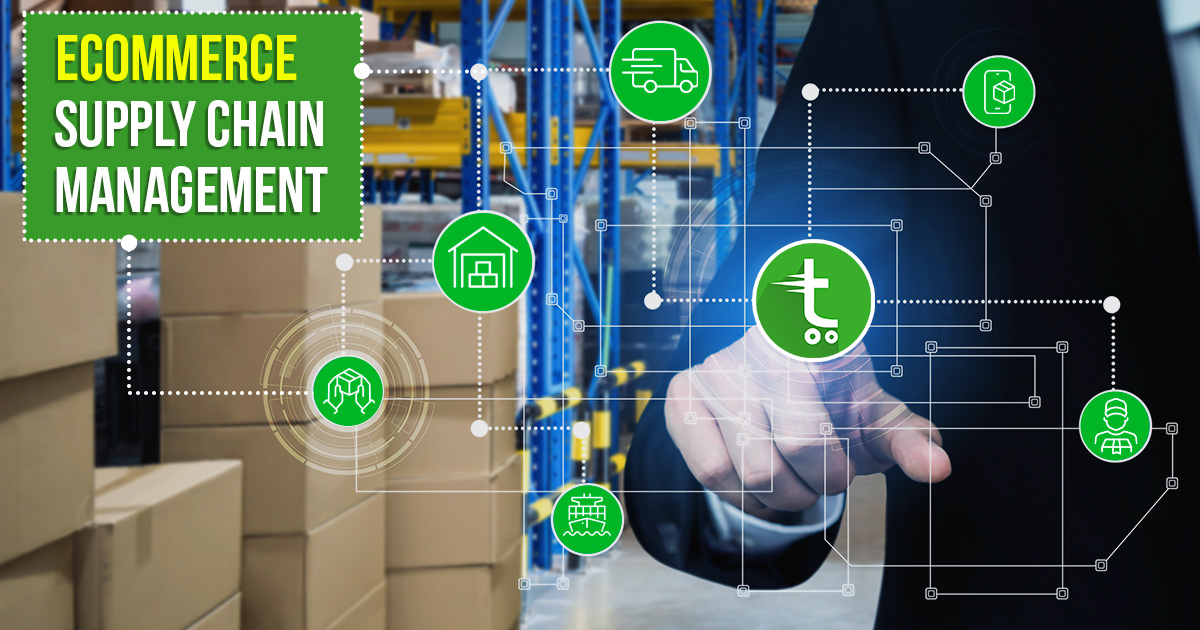
Running an ecommerce business is a complex task. There are many moving parts and pieces that need to come together for your business to be successful. One of the most important aspects of ecommerce shipping is supply chain management. This aspect of a business is often overlooked, but it is vitally important. Unfortunately, many businesses tend to ignore their supply chain until there is a problem. This can be a big mistake. By proactively managing your supply chain, you can avoid many potential problems down the road.
So, what are some best practices for ecommerce supply chain management? We will discuss that in this blog post. Today, we will talk about some of the best practices for ecommerce supply chain management. Following these tips can streamline your process and improve your bottom line!
What is Ecommerce Supply Chain Management?
Before we dive into the best practices, let’s first take a step back and understand what ecommerce supply chain management is.
In short, ecommerce supply chain management is the process of managing the flow of goods and materials throughout the entire supply chain. This includes everything from sourcing raw materials to manufacturing products to delivering them to the customer.
It’s a complex process but vitally important for ecommerce businesses. A well-run supply chain can mean the difference between success and failure.
There are many different factors that need to be managed to run a successful ecommerce fulfillment. Let’s take a look at some of the best practices for ecommerce supply chain management.
Best Practices for Ecommerce Supply Chain Management
There are many different factors to consider when managing your supply chain. But, a few key practices can make a big difference.
By following these best practices, you can improve your ecommerce business in a number of ways. First, let’s look at some of the best practices for supply chain management.
Streamline the Inbound Supply Chain
Improve your ecommerce business to streamline the inbound supply chain. This includes everything from sourcing raw materials to manufacturing products.
There are a number of ways to streamline the inbound supply chain. One way is to consolidate your suppliers. This means working with fewer suppliers that can provide a broader range of products.
This can be a challenge but worth it in the long run. By consolidating your suppliers, you can reduce costs and simplify the process. Another way to streamline the inbound supply chain is to automate as much as possible. This includes using technology to track inventory levels and manage orders. By automating the inbound supply chain, you can free up time and resources that can be better used elsewhere.
Here are the usual trucks and light delivery vehicles you can use to deliver and procure orders using the Transportify app.
| Vehicle Type | Dimensions/ Weight Limits | Base Price (Metro Manila) | Base Price (Outside Metro Manila) | Base Price (Visayas/Mindanao) |
|---|---|---|---|---|
 Wing Van Wing Van | 32 to 40 x 7.8 x 7.8 ft 12000kg to 28000kg | 7000 PHP | 6500 PHP | 6500 PHP |
| 18 x 6 x 7 ft 7000kg | 4850 PHP | 4850 PHP | 4850 PHP | |
 Closed Van Closed Van | 10 to 14 x 6 x 6 ft 2000kg to 5000kg | 1600 PHP | 1450 PHP | 1450 PHP |
 Open Truck Open Truck | 10 to 21 x 6 ft x open 2000kg and 7000kg | 2300 PHP | 1950 PHP | 1950 PHP |
 L300/Van L300/Van | 8 x 4.5 x 4.5 ft 1000kg | 415 PHP | 374 PHP | 335 PHP |
 Small Pickup Small Pickup | 5 x 5 ft x open 1000kg | 418 PHP | 338 PHP | 325 PHP |
| 5.5 x 3.8 x 3.8 ft 600kg | 375 PHP | 292 PHP | 275 PHP | |
| 5 x 3.2 x 2.8 ft 200kg | 240 PHP | 210 PHP | 160 PHP | |
| 3.5 x 2 x 2.5 ft 200kg | 220 PHP | 190 PHP | 140 PHP |
Reduce Shipping Cost and Delivery Time
One of the biggest challenges for ecommerce businesses is managing shipping costs and delivery times.
Shipping costs can eat into your profits, so it’s important to find ways to reduce them. One way to do this is to consolidate orders. This means grouping orders from different customers and delivering them in one batch. This can be a challenge but worth it in the long run. By consolidating orders, you can reduce shipping costs and delivery times.
Another way to reduce shipping costs is to use technology. There are a number of software programs that can help you automate the shipping process. By using technology, you can reduce errors and save time. This can lead to lower shipping costs and happier customers.
Expand Your Warehouse Capacity
As your ecommerce business grows, you will need to expand your warehouse capacity. This means adding more space to store inventory.
It can be a challenge to find the right location and the right amount of space. But, it is important to plan for growth. By expanding your warehouse capacity, you can avoid disruptions in the supply chain. That’s why doing this can help in your supply chain management.
Make Paperwork Process Quicker
One of the most important, but often overlooked aspects of supply chain management is the paperwork process.
This includes everything from filling out customs forms to getting the right permits. It’s a complex and time-consuming process, but it is vitally important. There are a number of ways to make the paperwork process quicker. One way is to automate your documentation and delivery transactions. This includes using software to fill out forms and track documents. Another way to make the paperwork process quicker is to hire a customs broker. A customs broker can help you navigate the complex world of international trade. By using a customs broker, you can save time and money.
Simplify the Manual Processes
Simplifying the manual processes can better improve your supply chain. In any ecommerce business, there are going to be manual processes. This includes everything from packing and shipping orders to returns and exchanges.
The key is to simplify these manual processes as much as possible. You can leverage the power of technology. For example, you can use software to automate the order-taking process and dispatching of orders to drivers. Another way to simplify manual processes is to hire detail-oriented employees who can follow instructions. Make sure that your employees are trained on the manual processes. This will help to ensure that they are done correctly and in a timely manner.
Consider Using Third-Party Logistics Service
Using a third-party logistics service is vital for better ecommerce supply chain management. A third-party logistics service can help you with a number of different aspects of the supply chain. This includes everything from warehousing and shipping to customer service.
Using a third-party logistics service can greatly help increase your order fulfillment, especially if you are just starting. They can provide you with the necessary resources and expertise to succeed. By using a third-party logistics service, you can focus on other aspects of your ecommerce business. This will free up time and resources that can be better used elsewhere.
SEE ALSO:
- Nationwide Delivery Services of Transportify (Interisland)
- Freight Forwarding: What Is It and Why Does It Matter?
- Importance of Logistics and Transportation in Supply Chain Management
Get Logistics Services from Transportify
If you are looking for a third-party logistics service, Transportify can help. We offer a wide range of ecommerce logistics services. This includes everything from warehousing and shipping to customer service.
We also offer real-time tracking. This means that you can track your shipments at any time. Transportify is the perfect solution for ecommerce businesses of all sizes. We offer competitive pricing and a wide range of services. Contact us today to learn more about how we can help you with your ecommerce supply chain management.
 | or |
Frequently Asked Questions:
What is ecommerce supply chain management?
🚚 Ecommerce supply chain management manages the flow of goods and resources between the point of origin and the point of consumption to meet customer demand. It encompasses everything from sourcing and procurement to manufacturing, logistics, warehousing, and distribution. An effective ecommerce supply chain management strategy is critical for businesses that want to compete in today’s marketplace. By streamlining operations and maximizing efficiency, businesses can improve their bottom line while providing customers with the products they want when they want them.
What are some best practices for ecommerce supply chain management?
🚚 Some best practices for supply chain management include expanding your warehouse capacity, making the paperwork process quicker, and simplifying the manual processes. All these things will contribute to a better ecommerce supply chain because they will make the process more efficient.




 INSTANT QUOTE
INSTANT QUOTE

 Chat
Chat